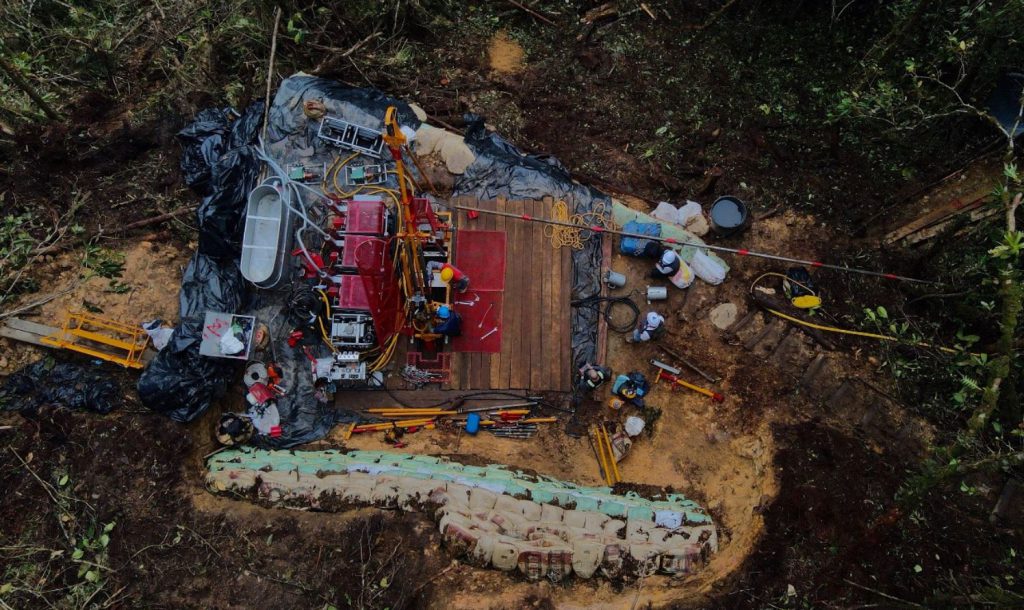Libero Copper & Gold drills 0.46% CuEq over 1,141metres from surface at Mocoa, Colombia

Libero Copper & Gold Corp. [TSXV: LBC; OTCQB: LBCMF; DE: 29H] reported results from the first diamond drill hole (MD-044) of its 14,000-metre resource expansion drilling program at the Mocoa porphyry copper-molybdenum deposit in Putumayo, Colombia, Libero Copper’s flagship asset.
MD-044 was designed to fill-in the current geological model that indicated a prospective feed zone to the deposit. The hole confirmed mineralization from surface to the final drill depth which remains open. These results strengthen Libero Copper’s geological model and lay the foundation for additional step-out drilling aimed at significantly expanding the existing resource.
Highlights – 1,141 metres of continuous mineralization: Hole MD-044 intersected 1,141 metres grading 0.46% CuEq (0.27% Cu and 0.04% Mo) from surface to end of hole (EOH).
Robust high-grade intervals: 542-metre segment averaged 0.69% CuEq (0.41% Cu and 0.07% Mo) from 281 to 824 metres, including 389 metres grading 0.76% CuEq (0.45% Cu and 0.07% Mo) from 293 to 682 metres.
Extension of high-grade core zone: MD-044 extended the northeast-trending high-grade core zone at depth and intersected high-grade values in a “gap” area, suggesting a potential connection between two high-grade zones. These results underscore the scale and grade of the Mocoa deposit and support further exploration aimed at expanding and upgrading the resource base.
Evidence of multi-stage mineralization: Alteration and mineralization observed in MD-044 indicate a complex, prolonged hydrothermal system typical of deep-rooted feeder structures, highlighting the potential for continued resource growth.
Newly identified diorite-porphyry unit: The hole ended in a potassic-altered early diorite-porphyry not previously recognized at Mocoa. Further drilling will help refine the geological interpretation of this unit and its role in the broader porphyry system.
“Years of groundwork—community collaboration, technical modeling, and strategic partnerships—have brought us to this point, and I truly believe we are only beginning to unlock Mocoa’s full potential,” stated Ian Harris, President & CEO. “MD-044, the first hole in our 14,000-metre program, delivered on its objectives—demonstrating remarkable scale, continuity, and broad copper-molybdenum mineralization from surface to end of hole, which remains open. It filled in critical geological knowledge and builds confidence in our ability to significantly expand the resource base. These first results already compare favourably to some of the world’s best copper projects, and we believe they will drive Mocoa toward a transformative next phase.”
Mineralized zones at Mocoa are bulk porphyry-style zones and drilled widths are interpreted to be very close to true widths.
Hole MD-044 is the first hole in the 14,000-metre drill program at the Mocoa porphyry Cu-Mo deposit. This hole was strategically drilled to test the high-grade zone continuity plunging to the northeast, below the existing conceptual pit-constrained Inferred resources. and to explore the potential connection between both high-grade core areas as part of the broader strategy to expand the current mineral resource of Mocoa.
Detailed Anaconda logging of MD-044 shows multiple alteration zones, providing insights into the complex hydrothermal evolution of the deposit. The initial 100 metres encountered argillic alteration dominated by iron oxides (after D-type veins), representing the bottom of the visible oxidation zone. This alteration is characteristic of the upper levels of the Mocoa porphyry system (see figure 3A) and is related to the de-magnetized zone and K-alteration index observed in the airborne magnetics and radiometric survey data.
As an overall, three main magmatic-mineralization stages are recognized at the Mocoa porphyry Cu-Mo deposit:
Stage 1 is related to the early intrusion of a quartz diorite porphyry with disseminated chalcopyrite and molybdenite and multiple generation of A and K-spar veinlets, locally truncated and crossing by B-type veins.
Stage 2 is related to a dacite porphyry with strong sericite alteration (locally overprinted potassic alteration) and multiple B and C type veining cross-cutting early A-type veins.
Stage 3 is related to the brecciation event which brings the highest Cu-Mo grade, observed in form of chalcopyrite and molybdenite as matrix-infill within a hydrothermal breccia with strong potassic alteration locally overprinting chlorite-sericite alteration as observed in hole MD-043.
All of these stages were consistently observed in MD-044 hole, providing clear evidence of the multi-stage mineralization events within the deposit and demonstrating the complex and prolonged hydrothermal activity that occurred within the Mocoa porphyry system.
It is notable that drill hole MD-044 ended at 1,141 metres still in mineralization (roughly 1,000 metres below surface) intersecting additional pyrite-epidote (with minor content of chalcopyrite) and QSP (quartz-pyrite-sericite) veins overprinted the earlier C-type and B-type veins suggesting the open-ended potential of the system. Further drilling will assist to refine the understanding of high-grade copper and molybdenum distribution and potentially expanding the resource through targeted infill and step-out drilling.
Mineralized zones at Mocoa are bulk porphyry-style zones and drilled widths are interpreted to be very close to true widths.
The Mocoa deposit is located in the department of Putumayo, 10 km from the town of Mocoa. Libero Copper’s district scale holdings cover over 1,000 km2 through titles and applications, encompassing most of the Jurassic porphyry belt in southern Colombia.
The Mocoa deposit appears to be open in both directions along strike and at depth. Current work on the property has identified additional porphyry targets including the possible expansion of known mineralization.
